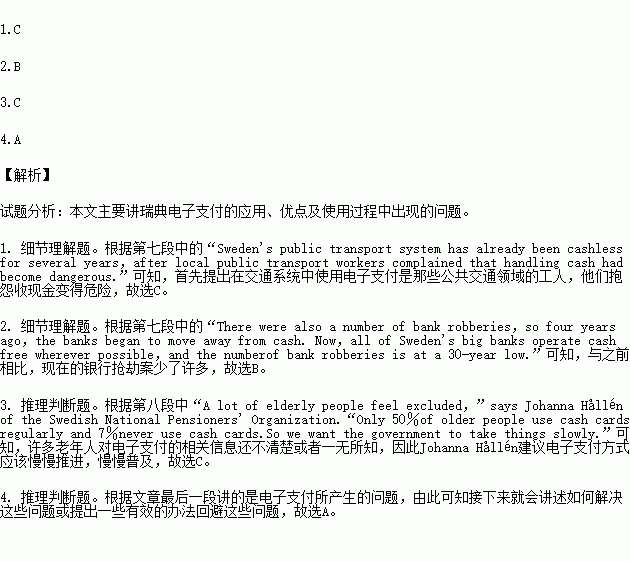题目内容
Stockholm’s street magazine sellers no longer only take cash — they now take cards too.
“More and more sellers were telling us that people wanted our magazine but weren’t carrying cash,” says Pia Stolt, the magazine’s publisher. “So with the help of a local computer company, we came up with a way to accept payment electronically.
“We didn’t know how it would turn out, or whether people would be unwilling to give the credit card information to a stranger on the street,” says Stolt, “but the results have been great—sales are up 59%.” “Swedes are pretty trusting and we’re used to taking up new technology so this was the perfect solution,” adds Stolt. “The cashless society campaign we’re seeing in Sweden is definitely a good move as far as we are concerned—it’s unstoppable.”
Banks and stores invested heavily in card payment systems in the 1990s and now local consumers are using them in huge numbers. Today, four out of five purchases are made electronically in Sweden and going totally cash-free is the next step.
Sweden’s public transport system has already been cashless for several years, after local public transport workers complained that handling cash had become dangerous. “Bus drivers were getting attacked for their money so Sweden banned cash on public transport,” says Arn Arvidsson, the president of Cashless, an organization supporting the move to a cash-free society. “There were also a number of bank robberies, so four years ago, the banks began to move away from cash. Now, all of Sweden’s big banks operate cash free wherever possible, and the number of bank robberies is at a 30-year low.”
There is, however, concern about how well Sweden’s 1.8 million pensioners—out of a total population of 10 million—will adapt. “A lot of elderly people feel excluded,” says Johanna Hallen of the Swedish National Pensioners’ Organization. “Only 50% of older people use cash cards regularly and 7% never use cash cards. So we want the government to take things slowly.”
The digital payment revolution is also a challenge for tourists, who need pre-paid tickets or a Swedish mobile to catch a bus in the capital. “There’s a worry about crime and theft as well,” says Arvidsson. “Figures show that computer-related credit card crime has almost doubled in the last decade.”
1.The demand for a cashless public transport system first came from _______.
A. transport companies to reduce their costs
B. banks so they could increase their profits
C. transport workers to protect their safety
D. the government to improve transport times
2.Which of the following about Sweden is true according to the passage?
A. No new banknotes will be produced in the future
B. There has been a huge reduction in bank robberies.
C. Local people don’t feel comfortable carrying cash.
D. It is the first country to have cash-free buses.
3.Why does Johanna Hallen think the cashless society should be introduced slowly?
A. She worries that computer-related crime will increase.
B. She is concerned about the inconvenience to foreign travellers.
C. She believes that it’s not easy for older people to get used to it.
D. She feels it is everyone’s right to be able to use cash if they wish.
4.What information is most likely to follow the last paragraph?
A. Some possible solutions to the problems of a cashless society.
B. The reasons for the change in customers’ attitudes to cards.
C. Some benefits a cashless society will bring to banks
D. The difficulties people face in a cashless society.
 励耘书业暑假衔接宁波出版社系列答案
励耘书业暑假衔接宁波出版社系列答案
